人教版小学英语六年级上册第一课
六年级英语上册第一课
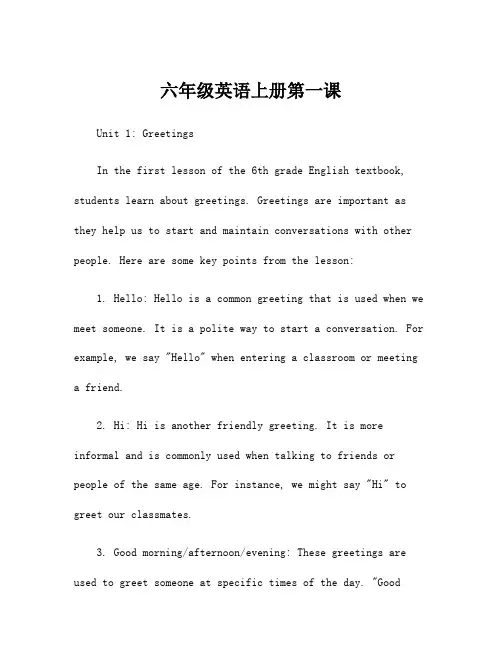
六年级英语上册第一课Unit 1: GreetingsIn the first lesson of the 6th grade English textbook, students learn about greetings. Greetings are important as they help us to start and maintain conversations with other people. Here are some key points from the lesson:1. Hello: Hello is a common greeting that is used when we meet someone. It is a polite way to start a conversation. For example, we say "Hello" when entering a classroom or meetinga friend.2. Hi: Hi is another friendly greeting. It is more informal and is commonly used when talking to friends or people of the same age. For instance, we might say "Hi" to greet our classmates.3. Good morning/afternoon/evening: These greetings are used to greet someone at specific times of the day. "Goodmorning" is used in the morning until around noon. "Good afternoon" is used from noon until evening, and "Good evening" is used after dark.4. How are you?: This is a common way to ask someone about their well-being. It's a polite way to show interest in the other person. When someone asks, "How are you?", we can reply with phrases like, "I'm fine, thank you" or "I'm good, and you?"5. Goodbye: Goodbye is used when we want to end a conversation or to say farewell. It's a polite way to end a conversation. For example, we say "Goodbye" to our friends when leaving school.6. See you later: This is an informal way to say goodbye when you expect to see the person again soon. It expresses the hope to meet again in the near future. For instance, we might say "See you later" to our classmates at the end of the school day.Remember, using appropriate greetings is an essential part of communication and helps us to build relationships with others. By using greetings, we show respect and kindness to those we meet. Practicing these greetings will make interactions more pleasant and enjoyable. So, let's greet others with a smile and start meaningful conversations!。
人教版新课标小学英语六年级教案(unit1whatclassareyouin)
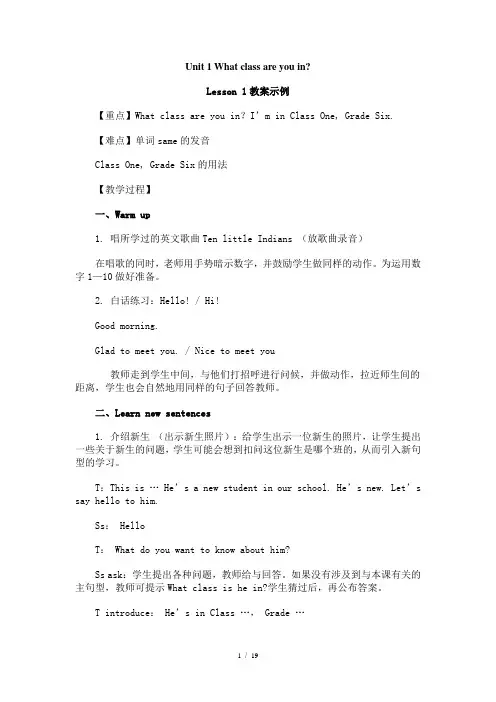
Unit 1 What class are you in?Lesson 1教案示例【重点】What class are you in?I’m in Class One, Grade Six.【难点】单词same的发音Class One, Grade Six的用法【教学过程】一、Warm up1. 唱所学过的英文歌曲Ten little Indians (放歌曲录音)在唱歌的同时,老师用手势暗示数字,并鼓励学生做同样的动作。
为运用数字1—10做好准备。
2. 白话练习:Hello! / Hi!Good morning.Glad to meet you. / Nice to meet you教师走到学生中间,与他们打招呼进行问候,并做动作,拉近师生间的距离,学生也会自然地用同样的句子回答教师。
二、Learn new sentences1. 介绍新生(出示新生照片):给学生出示一位新生的照片,让学生提出一些关于新生的问题,学生可能会想到扣问这位新生是哪个班的,从而引入新句型的学习。
T:This is … He’s a new student in our school. He’s new. Let’s say hello to him.Ss: HelloT: What do you want to know about him?Ss ask:学生提出各种问题,教师给与回答。
如果没有涉及到与本课有关的主句型,教师可提示What class is he in?学生猜过后,再公布答案。
T introduce:He’s in Class …, Grad e …2. 句型What class are you in? I am in class one师生问答T:He’s in Class…Grade … What class are you in?[板书:in Class…Grade…]教师带读板书内容,先让学生熟悉答案的基本框架S:In Class…Grade…T示范:I’m in Class…Grade…教师示范完整句,为下一步的问答打基础全体学生跟读、分小组读句子、找个别学生读3. 学生之间问答教师带读 What class are you in?学生之间进行问答,可先找一些学习基础好的学生与教师做示范练习,然后给学生几分钟时间做准备,以固定组和自由结合的形式进行问答。
六年级上册英语第一课人教版
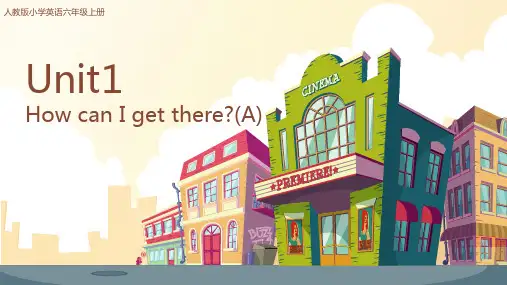
Where is +地点名词
意思:……在哪里
解读:where副词,意思“在哪里,到哪里” 答语:It is +表示位置的介词+地点
例句: Where is your school? It is near the museum.
知识点讲解
2、excuse me 有礼貌
excuse me 在口语中应用非常广泛,常用在以下几种情形:
the left。
Mike:Thank you.
Chen:You’re welcome.
Put these instructions to the shoe store in order 排序
(1)Walk straight for three minutes to the hospital. (2)Get on the No.301 bus. (3)Get off at the cinema. (4)Go next to the shoe store.
知识点讲解
3、感叹句的用法
感叹句用来表达喜怒哀乐等强烈感情。它通常用what或者how引导。结构如下:
(1)What a/an +形容词+可数名词单数(+主语+谓语)
What a clever boy he is! 他是多么聪明的一个男孩啊! What beautiful flowers! 多漂亮的花呀!
用于引起别人(尤其是陌生人)的注意,意 为“劳驾,请原谅”
Excuse me
用于客气地请别人让路,意为“对不起,劳 驾”
用于因打扰别人或失礼而表示歉意,意为 “对不起,请原谅”
知识点讲解excuse me VS Nhomakorabeaorry
人教版小学英语六年级上册第一单元第一课时PPT课件
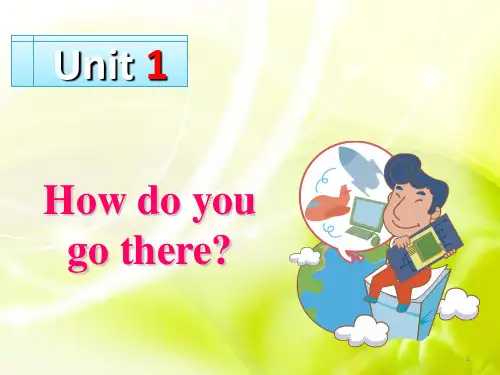
words box
on foot by bus
by taxi by car
25
Ss: How do you go to work? T: Usually I go to work by bus.
Sometimes I go by bike.
Mon. Tue. Wed. Thu.
Fri.
usually
sometimes
26
LiuYun’s home
L: Usually I go to school by bus. Because my home is far. Sometimes I go by taxi. Because it’s fast.
by bike
near far
fast
slow
healthy cheap
expensive
28
29
Q1: How does Sarah go to school? Why? Q2: How does Liu Yun go to school? Why?
30
写在最后
经常不断地学习,你就什么都知道。你知道得越多,你就越有力量 Study Constantly, And You Will Know Everything. The More
16
17
ship
18
19
train
20
train
subway
21
22
小学英语六年级上册第一课
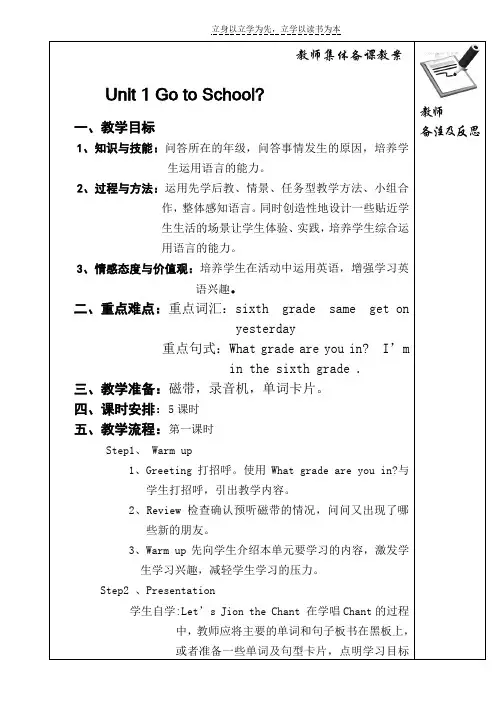
D、stopped重读闭音节单词的过去式应双写末尾的辅音字母,然后加“ed”
Step3、Practice
以生代师:1、Follow the leader(组长领读)
2、Review检查确认听磁带的情况。
3、问答录音内容及重点词句,根据反馈情况,提示3课时的学习目标。
Step2、Presentation
学生自学: Let’s Jion the Chant讲Chant中的内容和语句,同时教师应将主要的单词和句子板书在黑板上,或准备一些单词及句型卡片,指明自学目标。
1、总结本节课的学习内容
2、作业
3、道别语
六、板书设计:
Unit 1 Go to School?
sixth same grade get on
What grade are you in?
I’m in the sixth grade
教师
备注及反思
年级:六年学科:英Biblioteka 主备曹艳秋教师集体备课教案
一、课时安排:第二课时
二、教学流程:
Step1、Warm up
1、Greeting打招呼。
2、Review检查确认预听磁带的情况。
Step2、Presentation
学生自学:Let’s Practice 1
Look at the picture and let them understand the dialogue(用学到新单词看图理解对话并译成汉语)
激励评价: Check and assessment:对读的;汇报好的同学及小组给予积极的评价
Step4、Production
六年级上册第一课英语课文读
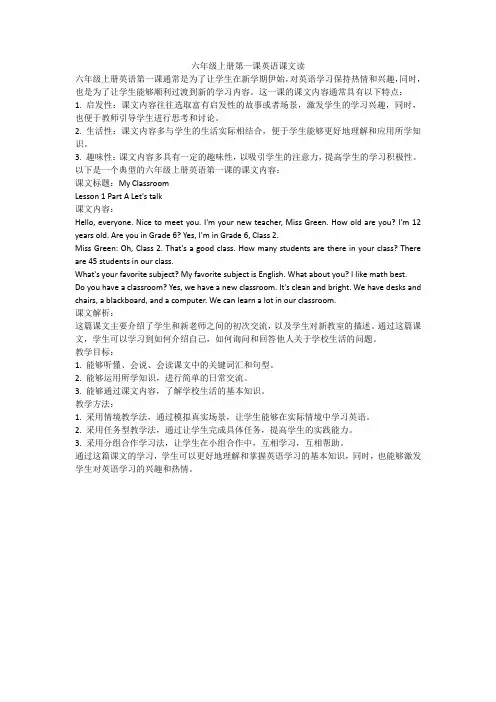
六年级上册第一课英语课文读六年级上册英语第一课通常是为了让学生在新学期伊始,对英语学习保持热情和兴趣,同时,也是为了让学生能够顺利过渡到新的学习内容。
这一课的课文内容通常具有以下特点:1. 启发性:课文内容往往选取富有启发性的故事或者场景,激发学生的学习兴趣,同时,也便于教师引导学生进行思考和讨论。
2. 生活性:课文内容多与学生的生活实际相结合,便于学生能够更好地理解和应用所学知识。
3. 趣味性:课文内容多具有一定的趣味性,以吸引学生的注意力,提高学生的学习积极性。
以下是一个典型的六年级上册英语第一课的课文内容:课文标题:My ClassroomLesson 1 Part A Let's talk课文内容:Hello, everyone. Nice to meet you. I'm your new teacher, Miss Green. How old are you? I'm 12 years old. Are you in Grade 6? Yes, I'm in Grade 6, Class 2.Miss Green: Oh, Class 2. That's a good class. How many students are there in your class? There are 45 students in our class.What's your favorite subject? My favorite subject is English. What about you? I like math best.Do you have a classroom? Yes, we have a new classroom. It's clean and bright. We have desks and chairs, a blackboard, and a computer. We can learn a lot in our classroom.课文解析:这篇课文主要介绍了学生和新老师之间的初次交流,以及学生对新教室的描述。
人教版小学英语六年级上册Unit 1 How can I get there?第二课时教案
人教版小学英语六年级上册Unit 1How can I get there?第二课时教案一、课时内容A Let’s try Let’s talk课时分析本课时是人教版六年级上册第一单元的第二课时,与第一课时紧密相连,围绕“场所的方位”展开话题。
本节课主要是通过谈话的情景继续学习询问场所的方位及回答的句型Where is the...? 并且引导学生能运用礼貌用语寻求他人的帮助。
第一课时中句型Where is the..? It’s next to...的学习,为本课时奠定了基础。
本课时的重点是能在情景中灵活运用句型Where is the..? It’s next to...交流场所的方位及课文对话的理解。
本课时包括Let’s try 和Let’s talk 两个版块。
Let’s try是听力训练,通过吴一凡和Robin的对话,引出A Let’s talk版块的对话场景信息,并复现表示地点方位的句型Where is the...?为进入正式的对话学习做好准备。
Let’s talk 呈现的是吴一凡和Robin在博物馆看机器人,吴一凡想要买明信片,从而引起对于博物馆商店、邮局方位的询问。
本课时询问场所的方位情景的设置,贴近学生的生活,激发了学生求知欲望,鼓励了学生想要用英语表达的热情。
本课时出现的词汇postcard, send, ask, sir,可以借助于一定的语境,肢体语言,图片等方法帮助学生理解和记忆。
在课堂教学中,我采用游戏复习词汇,问答复习句型,然后通过Let’s try引出对话,整体感知对话,局部处理语言,帮助学生更好的理解和运用语言。
最后在通过游戏、创编对话的环节巩固所学语言。
二、课时目标1. 能够听、说、认读单词:postcard, send, ask, sir2. 能够听、说、读、写句型:Where is the museum shop? It’s near the door.3. 能够在任务情景中运用句型Where is the...? It’s...4. 能够按照正确的意群及语音、语调朗读对话。
小学英语人教PEP版六年级上册第一课时_课件
猜谜语
1.We can send a letter in the ( post office ) . 2.We can see the films at the ( cinema ). 3.If we are sick, we should go to the
( hospital ). 4.We can watch a dinosaur show in the ( science museum ). 5.We can buy some books in the ( bookstore).
Wu: These robots are so cool. I love this museum. Robin: Me too. Don't forget to buy some gifts for grandpa. Wu: I know. But I really need to go to the bathroom. Where is it? Robin: It's on the second floor. Wu: OK. Thanks.
3 bookstore
cinema hospital
Science 2 museum
post office 1
Preview
There is a post office in my city. It’s behind the hospital. Where is it?
3 bookstore
cinema hospital
I love this museum Don’t forget to buy some gifts for Grandpa.
Let’s try
Wu Yifan and Robin are looking at some robots. Listen and tick.
小学英语人教pep版六年级上册u1第一课时课件
3 bookstore
cinema hospital
Science 2 museum
需要更完整的资源请到 新世纪 教育网 -
post office 1
Let’s try
Wu Yifan and Robin are looking at some robots. Listen and tick.
cinema hospital
Science 2 museum
需要更完整的资源请到 新世纪 教育网 -
post office 1
Preview
There is a post office in my city. It’s behind the hospital. Where is it?
3 bookstore
cinema hospital
Science 2 museum
需要更完整的资源请到 新世纪 教育网 -
post office 1
Preview
There is a science museum in my city. It’s near the hospital. Where is it?
小学英语(PEP)六年级上册
Unit 1 How can I get there?
第一课时
需要更完整的资源请到 新世纪 教育网 -
Warm-up
Let’s sing
需要更完整的资源请到 新世纪 教育网 -
Warm-up
Hello, nice to meet you. What’s the weather like today?
Preview
It’s a postcard. post office Robin wants to send a postcard. Where should he go?
人教版六年级英语上册Unit1(第一课时ALet’slearn;Makeamapandtalk)教案
第一课时课时内容A Let’s learn ;Make a map and talk课时分析本课时是人教版六年级上册第一单元第一课时。
围绕Where is the...?这一话题展开,主要通过对话学习词汇science museum, post office, bookstore, cinema, hospital及句型Where is the...? It’s next to...的表达。
引导学生了解一些简单的构词规律,发音规律,培养学生学习英语的热情,树立学好英语的信心。
第一课时是本单元的基础,学会了本课时所要掌握的知识,再学习其他课时就会很容易。
本课时的重点是四会单词的掌握以及能够运用四会单词介绍场所的位置。
本课时包括Let’s learn 和Make a map and talk 两个版块。
Let’s learn呈现了吴一凡和Robin的对话,体现了单词及词组的词形和意义。
此版块呈现的对话情境是吴一凡问Robin电影院在哪,Robin告诉吴一凡在书店旁边。
此情境贴近学生的实际生活,很能激发学生学习的兴趣。
Make a map and talk版块是一个综合性的操练活动。
学生可以通过这个活动巩固A 部分Let’s learn所学的词汇和句型,做到学以致用。
本课时虽然是新授课,但是四会单词和词组比较简单,所以学生很容易掌握。
在设计教学过程时,遵循以学生为主体的原则,采用猜一猜、说一说、读一读、玩一玩、儿歌等多种教学手段调动全体学生的积极参与。
通过任务型教学法、合作探究教学法等引导学生自主学习。
课时目标(1)能够听、说、读、写单词:science museum, post office, bookstore, cinema, hospital。
(2)能够运用所学词汇介绍场所的位置。
(3)了解一些简单的构词规律和一些简单的发音规律。
(4)能够听、说、运用句型Where is the...? It’s next to...(5)培养学生学习英语的热情,树立学好英语的信心。
- 1、下载文档前请自行甄别文档内容的完整性,平台不提供额外的编辑、内容补充、找答案等附加服务。
- 2、"仅部分预览"的文档,不可在线预览部分如存在完整性等问题,可反馈申请退款(可完整预览的文档不适用该条件!)。
- 3、如文档侵犯您的权益,请联系客服反馈,我们会尽快为您处理(人工客服工作时间:9:00-18:30)。
Let’s go to the Pearl River Cruise? Yes,than would be fun. No,thank. Yes,than would be gread. a lof of=a plenty of
go to Xiajiu Road
have dimsum at the famous GZ Restaurant.
ห้องสมุดไป่ตู้buy new clothes
go on the Pearl River Cruise
go to Xiangjiang Zoo … Go to Six Banyan Temple
Go to Baiyun Hill
to后面加V.原
Janet is going to skip with her fiends at home this afternoon.
Xiaoling is going to play cards with her fiends at home this afternoon.
Ben is going to surf the Net at home this afternoon.
次数 We have been to the zoos in GZ many times. We can see more birds at the zoo than on Baiyun Hill.
We have been to BJ many times
We can see more tree on Baiyun Hill than at the Zoo.
many-more-most instead all of us Pearl River Cruise
Six Banyun Temple
be going to 将来时
Yongxian is going to do some reading at the library this afternoon.
Sally is going to write a letter at home this afternoon.
Jiamin is going to have lunch at home.
